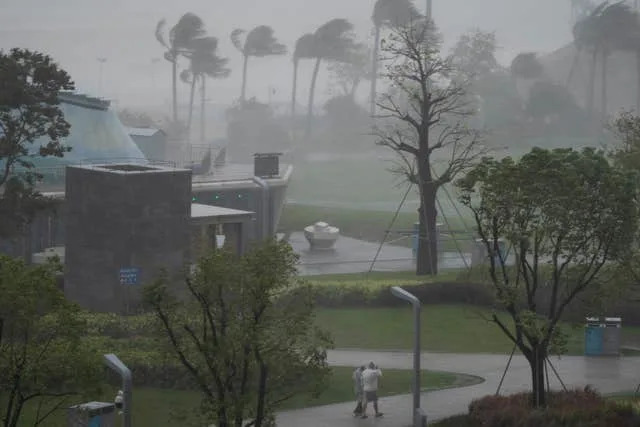Sports
Typhoon Ragasa Devastates Taiwan, Hong Kong, and Southern China

A powerful storm, Typhoon Ragasa, has wreaked havoc across parts of East Asia, causing significant loss of life and widespread destruction. The typhoon made landfall on March 15, 2024, hitting the coast of Hailing Island in Yangjiang, China, after first inflicting damage in Taiwan and the Philippines. In Taiwan alone, at least 15 people have died due to severe flooding, while 10 fatalities were reported in the Philippines.
The storm has triggered extensive evacuations, particularly in Guangdong province, where nearly 1.9 million residents were relocated. This southern Chinese province is a crucial economic hub, and the impact of the typhoon has been felt deeply across various sectors. Maximum wind gusts reached approximately 150 mph in affected areas, leading to treacherous conditions and significant damage.
Destruction and Displacement in Taiwan and the Philippines
In Taiwan, the typhoon’s effects were devastating. Heavy rain caused a barrier lake in Hualien County to overflow, leading to torrents of muddy water that destroyed infrastructure, including a bridge. Roads in the town of Guangfu turned into rivers, sweeping away vehicles and furniture. The local population of approximately 8,450 was severely impacted, with many seeking refuge on higher ground as rescuers scrambled to reach more than 100 individuals who were initially unreachable.
In the northern Philippines, the typhoon took a deadly toll as well, particularly affecting the province of Cagayan. Seven fishermen drowned when their boat capsized in turbulent waters, and five others remain missing. Authorities estimate that nearly 700,000 people were affected across the main northern region of Luzon, with approximately 25,000 people fleeing to emergency shelters.
Impact on Hong Kong and Southern China
As Typhoon Ragasa approached, Hong Kong braced for its impact. The storm’s fierce winds disturbed the city in the early hours, prompting residents to report incidents of fallen trees, damaged buildings, and chaotic scenes along the waterfront. A vessel crashed onto the shore, shattering glass railings, and at least 80 individuals were treated for injuries at local hospitals.
The Hong Kong Observatory reported maximum sustained winds near the centre of Ragasa at 120 mph, which resulted in the suspension of schools, factories, and transportation services across about a dozen cities. As the winds began to weaken in the afternoon, some areas began preparations to resume normal activities, although the impact on daily life remains significant.
In Macao, a nearby casino hub, flooding turned streets into streams, prompting local authorities to deploy rescue crews using inflatable boats to assist those trapped by rising waters. The local electricity supplier suspended power in certain areas for safety, further complicating recovery efforts.
The devastation caused by Typhoon Ragasa serves as a stark reminder of the vulnerability of coastal communities to severe weather events. As recovery efforts continue, authorities face the challenge of addressing immediate needs while planning for long-term resilience against future storms.
-

 Politics4 weeks ago
Politics4 weeks agoSecwepemc First Nation Seeks Aboriginal Title Over Kamloops Area
-

 World5 months ago
World5 months agoScientists Unearth Ancient Antarctic Ice to Unlock Climate Secrets
-

 Entertainment5 months ago
Entertainment5 months agoTrump and McCormick to Announce $70 Billion Energy Investments
-

 Science5 months ago
Science5 months agoFour Astronauts Return to Earth After International Space Station Mission
-

 Lifestyle5 months ago
Lifestyle5 months agoTransLink Launches Food Truck Program to Boost Revenue in Vancouver
-

 Technology3 months ago
Technology3 months agoApple Notes Enhances Functionality with Markdown Support in macOS 26
-

 Lifestyle3 months ago
Lifestyle3 months agoManitoba’s Burger Champion Shines Again Amid Dining Innovations
-

 Top Stories2 months ago
Top Stories2 months agoUrgent Update: Fatal Crash on Highway 99 Claims Life of Pitt Meadows Man
-

 Politics4 months ago
Politics4 months agoUkrainian Tennis Star Elina Svitolina Faces Death Threats Online
-

 Sports5 months ago
Sports5 months agoSearch Underway for Missing Hunter Amid Hokkaido Bear Emergency
-

 Politics5 months ago
Politics5 months agoCarney Engages First Nations Leaders at Development Law Summit
-

 Technology5 months ago
Technology5 months agoFrosthaven Launches Early Access on July 31, 2025





















